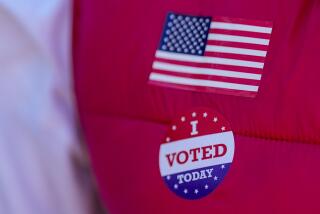Mudslinging Thrives Because Top Issues Aren’t in Dispute
- Share via
This may be the year of the negative campaign and voter apathy. But, contrary to much that has been written about Campaign ‘86, these are signs of a healthy, not a degenerate, body politic.
There is, of course, nothing attractive about mudslinging, nearly libelous name-calling and premeditated misrepresentation of one’s opponent’s views. The negative campaign does nothing to endear us to those who are its perpetrators.
But neither should we be taken in by the appearance of high-mindedness displayed by some politicians when piously denouncing their opponents’ canards. Avoiding the gutter is usually as calculated a campaign strategy as climbing into it. The best--and certainly the most hilarious--current example is the Pennsylvania gubernatorial race in which Republican William Scranton III, bested by his opponent in an exchange of charges, announced an end to negativism--only to witness the release by campaign workers of a suddenly out-of-date anti-Robert P. Casey pamphlet.
And before we declare the 1986 campaign the most negative in history, we should recall the election of 1884 in which Grover Cleveland had to explain the origins of his “illegitimate” son and James Blaine unsuccessfully tried to repudiate a supporter’s charge that the Democratic Party was the party of “rum, Rome and rebellion.” Also, Ronald Reagan’s return to the anti-Carter theme in 1986 is but a pale reflection of Republican efforts in the 19th Century to revive Civil War memories by waving the “bloody shirt” at their “copper headed” Democratic opponents.
Instead of moralizing about the negative campaign of 1986, it may be worth considering instead the political context that gives rise to negativism. Why do candidate personalities, congressional attendance records, minor misstatements and trivial issues dominate some elections more than others? The answer now, as in the late 19th Century, is that the trivial becomes central when major issues are not open to dispute. In the 1980s, as in the 1880s, everything may not be right about America. But nothing much is obviously wrong.
The United States is in the fourth year of economic recovery; if growth is not above the magic 3% number, neither has it stumbled into a minus figure. Unemployment percentages remain steady; inflation has fallen and remains stable at a tolerably low level; interest rates continue to ease downward, and even the balance-of-trade figures have begun to stabilize.
Equally important, the United States has remained at peace for more than a decade. The Western alliance remains intact, the superpowers seem unlikely to become deeply embroiled in regional conflicts and, if Reykjavik seems as much public relations as reality, it at least shows that Soviets and Americans are on speaking terms.
There are plenty of potential political issues that can absorb the attention of policy analysts. How long can we tolerate $200-billion budget deficits and $150-billion trade deficits? Is the Strategic Defense Initiative worth an arms race? How can America become more competitive in an increasingly integrated world economy? How can we better integrate our growing minority population into our economy and society?
But to these questions there are no politically popular answers, and politicians can be excused for avoiding unattractive ones. The bullets, if they are to be bitten, are better chewed in January than in October.
In the meantime we might be grateful for the restless peace and uncertain prosperity that we are enjoying. If the voters choose to stay home on a bright November day when the issues are small and the choices few, can we blame them? If the price to be paid for the absence of issues is 30 seconds of TV negativism, could we not have simply flicked the switch?
More to Read
Get the L.A. Times Politics newsletter
Deeply reported insights into legislation, politics and policy from Sacramento, Washington and beyond. In your inbox twice per week.
You may occasionally receive promotional content from the Los Angeles Times.










